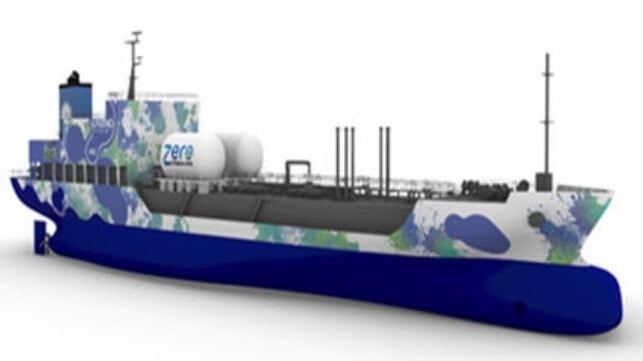Japanese Project Reaches Milestone in Design of Hydrogen-Fueled Tanker

A design project launched in Japan in 2023 reports it has reached a milestone in the development of a hydrogen-fueled domestic coastal tanker. The project which was launched under the sponsorship of The Nippon Foundation seeks to complete the demonstration vessel in 2025 and with a hydrogen-fueled engine start operations by 2026.
ClassNK reports it has reviewed the designs being developed by shipping company Uyeno Transtech, Yanmar Power Technology for the fuel supply system, and Mitsui E&S Shipbuilding. The first-ever approval in principle (AiP) certificate has been issued to the project’s designs for an oil tanker using liquid hydrogen as a fuel.
Ulyeno reports they have selected liquid hydrogen as the fuel because it allows for greater storage of the hydrogen. The ship will have a hydrogen capacity equivalent to approximately 2,500 standard hydrogen fuel cell vehicles. They highlight among the challenges is that liquid hydrogen has a boiling point of minus 253 degrees.
In the first concept, they were working on hydrogen power generation equipment on the upper deck. It called for a containerized unit. They are looking to transition to a hydrogen fuel engine in the engine room as the technology becomes available. The hydrogen-fueled engine generator would become the main engine for the vessel using electric power for propulsion. It is also designed to enable fuel cell power generation using boil-off gas mainly for onboard electricity.
The new 4,500-ton vessel will have a hull design specifically developed for the hydrogen plant and to serve as a demonstration ship. The report says the vessel will be approximately 100 meters (328 feet) with a capacity of 5,000 kiloliters. The engine will be a high-speed, four-stroke engine which they expect to be completed in 2026. The hydrogen fuel tanks will be placed on deck where the containerized system was originally located.
The plan calls for building the hull of the vessel for completion by June 2025. The team would then work to install the unique hydrogen systems for the 2026 demonstration voyages. Once in service, they project the vessel will reduce CO2 emissions by approximately 6,000 tons per year.
So far, hydrogen has mostly been used for smaller vessels and demonstrations. CMB’s Windcat launched the first hydrogen-fueled offshore crew transfer vessel using hydrogen and recently the Port of Antwerp put Hydrotug 1 in service. Most of the focus has been on hydrogen fuel cells as a power source with several cruise ships looking to use the fuel cells to provide in port power.
